This hero was full of apparent contradictions. He worked as a slave, performed almost impossible deeds, murdered in a frenzy and defended the weak. Roman emperors passionately appealed to him when planning their policies. Here's what you need to know about Hercules.
Greek Heracles and Roman Hercules are undoubtedly one of the most famous heroes of the ancient world. The phenomenon of including deities and mythical figures of other peoples into the Roman pantheon was, as we know, very common. However, Hercules plays a special role in this process. His character was not only accepted into Roman beliefs, but it was completely changed.
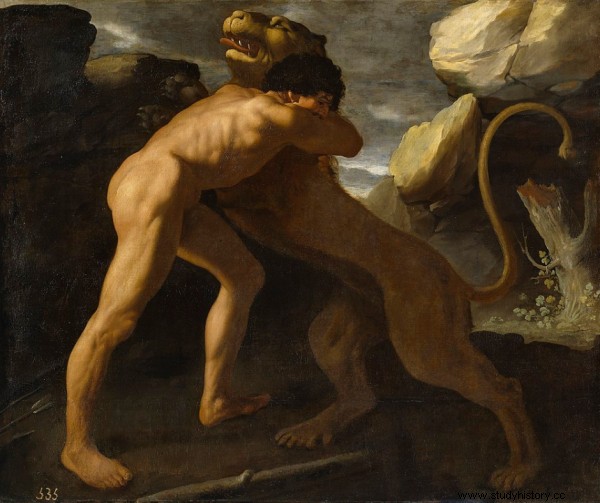
'Hércules lucha con el león de Nemea'. Francisco de Zurbarán
The wandering hero, defending the weaker and caring for animals, became a very special element of Roman religion and imperial ideology. His cult spread to far-flung provinces of the empire as well.
Heracles - the birth of a hero
According to Greek mythology, Heracles was the son of Zeus and queen Alkmena - the wife of the king of Thebes. His conception is related to a divine trick. For Zeus, desiring to possess Alkmena, appeared in the queen's chambers in the form of her husband Amphitryon the day before the king's return from a victorious war expedition. As a result of these visits and the king's return following them, Alkmena gave birth to twins - Heracles and Iphikles, weaker than him.
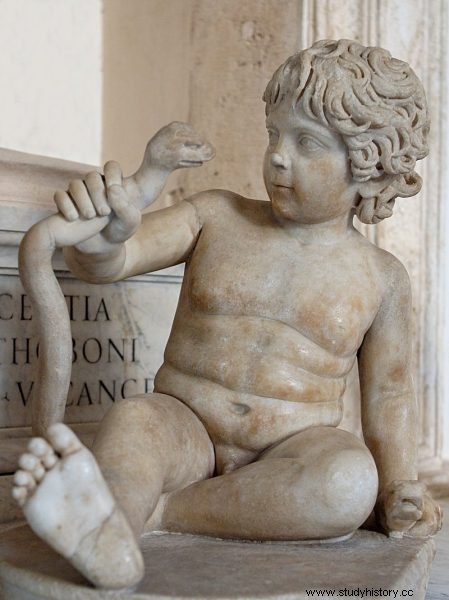
Heracles strangled the snakes that jealous Hera sent to his cradle with his bare hands
The Queen, fearing the wrath of Hera, ordered her maid to abandon Heracles. He was then found by his future protector - Athena. This persuaded Hera to feed the baby she found and thus gave him the opportunity to receive immortality. Athena then gave the child to Alkoman, who gladly took him back into her care. It is easy to imagine the frenzy Hera fell into when she realized the situation. In revenge, he sent poisonous snakes to Heracles' cradle, but the child easily strangled them. The hero spent his youth at his father's court, and all his life he was chased by the revenge of the jealous wife of Zeus.
Superhuman Works
As part of one of the acts of revenge, Hera sent her to madness. In majaki, the hero of Greek mythology saw his relatives as the greatest enemies and in such madness killed his beloved wife Megara and his children. Only Athena broke this frenzy by stunning Heracles. When the dizziness ceased, Heracles wanted to commit suicide, but instead went to the Delphic oracle to be punished for his actions. This is how he found himself at the court of King Eurystheus, where he made the famous 12 works of Heracles. Apollo knew that the cowardly king would come up with almost impossible tasks for the hero.
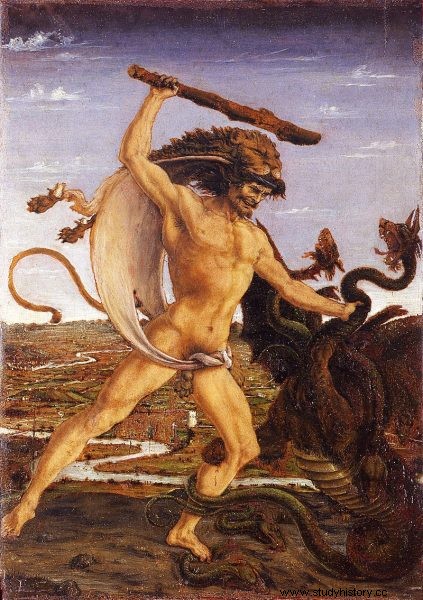
Heracles, while serving his sentence at the court of King Eurystheus, had to do 12 almost impossible jobs
The initial six works were to be performed by Heracles in the Peloponnesian Peninsula. Heracles' first task was to kill the Nemean lion , roaming the territory of the Nemean Valley northwest of Mycenae. The second task was to kill the Lerna Hydra which spread terror in the Lerna marsh near Argos. Subsequently, he had to catch a kerina doe without shedding blood - Artemis' favorite animal and capture the Erymantean boar who lived near Mount Erymantos in Arcadia and ravaged these areas. Fifth, he was cleansed the Augean stables . The sixth task was to drive out the Stymphalian birds from the area of Lake Stymfalon in Arkadia.
Heralkes has already completed six more works outside the Peloponnese. His seventh task was subjugating the Cretan bull , on the eighth the mare Diomedes was brought in son of Ares, king of the Thracian tribe of the Bistons. Then the acquisition of the belt of the Queen of the Amazons, Hippolytus. He was also supposed to kidnap Gerion's flock , son of Chrysaor. The penultimate job commissioned by Heracles was to get golden apples from the garden of the Hesperides . The last and most difficult of the jobs was the kidnapping of Cerberus - the dog guarding the underworld.
Not only choking with bare hands - hero attributes
The son of Zeus and Alkmena is recognized, among others, by thanks to its attributes. He carries a club in his hand, is covered in a lion skin, and a quiver filled with arrows hangs on his back. Heracles made the first two himself during one of his famous 12 works. Heracles stunned the Nemean lion with a hand-made club, and then strangled the beast with his bare hands. He pulled the skin off the slain animal with his hands, which has since become his trademark. The club, on the other hand, became his main weapon.
The symbolism of the club is extremely extensive. On the one hand, it is associated with glory and bravery, on the other hand, it equates to brutality, lightning, punishment or betrayal. . Heracles made his club from an oak tree, which additionally emphasizes the power and strength of the owner of such a weapon. The attributes of the solar heroes were made of oak. In the case of Heracles, the club additionally symbolized ferocity, cruelty and thunder.
Birth of a god
Heracles in his life made many more trips and did great deeds. He also married Dajanira, who later led to his undoing . After Heracles fatally wounded the centaur Nessos, he acted on Dejanira's feelings to take revenge on the hero. He promised her that if she obeyed all his orders, he would ensure his husband's undying faithfulness.
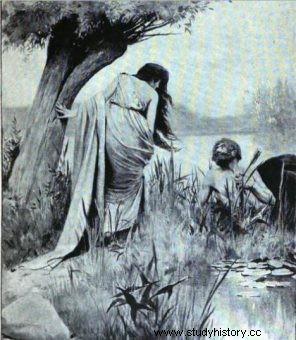
Desiring to ensure the fidelity of her husband, Dejanira accepted from the centaur Nessos the gift that led to the death of Heracles.
In one version of the myth, she received wool dipped in his blood from a centaur, and then used to make a shirt for her husband. Another version states that he donated her blood and his sperm, from which Dejanira was to prepare a mixture and then soak the finished shirt in it.
Regardless of the version of the myth, Dejanir accepted the gift and followed the instructions. She prepared a shirt which she then gave to her husband. Heracles, dressed in a gift from his wife, was offering a sacrifice to Zeus, when suddenly his clothes began to burn him. The hero was tearing off his shirt, but it was too late. To end his suffering, he was burned at the stake, and after his death, he was taken to Mount Olympus to join the other gods.
Heracles turns into Hercules - as the myth about the hero was adapted by the Romans
Heracles in the Roman world received a slightly changed name - Hercules. His cult appeared very early in the Roman religion, as early as 399 BCE. The hero was connected to Rome with one of his 12 works. While returning from the task of kidnapping Geryon's flock, Hercules was to stop in Italy on the Tiber, where he defeated the monster Cakusa. He then established his cult at the site of these events, where the altar Ara Maxima was built much later , located on the Roman Forum Boarium - the oldest Roman forum and commercial square.
The location of the cult in such a place meant that Hercules quickly won the hearts of merchants and traders. Therefore, he began to patronize them quite quickly and got his nickname Custos - guardian. At the altar of Ara Maxima commercial contracts were concluded and vows were made. With time, it was customary that 1/10 of the trade agreements concluded in this way was given to the patron god .
During the Samnite Wars, more and more attention was paid to the military side of Hercules. During this time, he obtained more nicknames Victor - winning and Invictus - undefeated. God therefore began to combine two contradictory aspects - he patronized merchants and military activities. However, this contradiction is only apparent. Trade cannot exist in times of war, and the trade routes were not very safe. Merchants were exposed to many dangers, such as attacks by pirates. A fighting patron seems to be extremely useful in such circumstances.
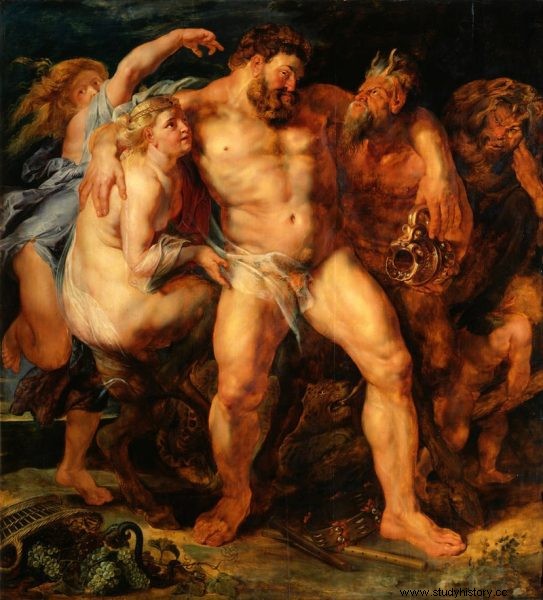
Hercules was a god who was very easily satisfied
Very soon, already around 300 BCE. the commercial nature of the cult of Hercules at Ara Maxima was replaced with the cult of its military incarnation. Hercules Invictus he also received his feast in the Roman calendar, which is August 12. During the celebration, sacrifices were made to the god in his honor and an annual free feast was organized, which was most likely financed by donations from the public.
Hercules / Heracles was a deity very easy to satisfy. He was famous for his greed, therefore he accepted literally everything in the sacrifice . The feast accompanying the victims was also characteristic of his cult, because nothing that was dedicated to him could be taken outside the sacred area. This meant that some of the victims, unburned on the altar, had to be eaten on the spot.
Hercules and politics
The role of Hercules grew, and his person appeared more and more often in the political activities of the emperors. He eventually became the patron deity of the imperial family . He began to gain favor with the emperors during the Flavian dynasty, especially during the reign of Domitian. However, the hero's popularity reached its peak during the reign of Trajan and his successors. It was during this period that Hercules began to be the guardian of the imperial house and gained his new nickname Hercules domus Augusti .
Referring to the figure of the famous hero quickly became an element of imperial propaganda. Pliny the Younger compared Trajan to this hero wandering around the world and helping the weaker. Dion Chrysostom, on the other hand, described him as a strong leader who is to his people what a shepherd is to the flock. Dressed only in a lion's skin, this hero cares for the welfare of all. Isn't that a picture of an ideal ruler?
Even the lack of a solid education could work for the ruler. Poets praising Emperor Trajan very quickly emphasized that the lack of education made the emperor a clean man and untouched by evil influences. Like a hero, he overcame tyrants and brought peace to the world. And just like he was going to be immortal someday. During the reign of Emperor Trajan, the ruler was first introduced as Hercules. This theme very quickly became an essential element of the imperial ideology.
The biggest fan of Hercules turned out to be Commodus, who, wanting to prove his divine right to exercise power, proclaimed himself "the new Hercules". He believed that he was the embodiment of a god on earth. In honor of the emperor, coins were minted with his image as Hercules or in the company of a hero. Such an image also appeared on the statues that in Roman times were the carriers of the rulers' ideology.
Commodus did not stop at portraying himself as Hercules. He often dressed like this god and displayed in public, and even fought in such attire as a gladiator. In this way, he wanted to show his people how much he resembled a hero who protects the world from chaos and danger.
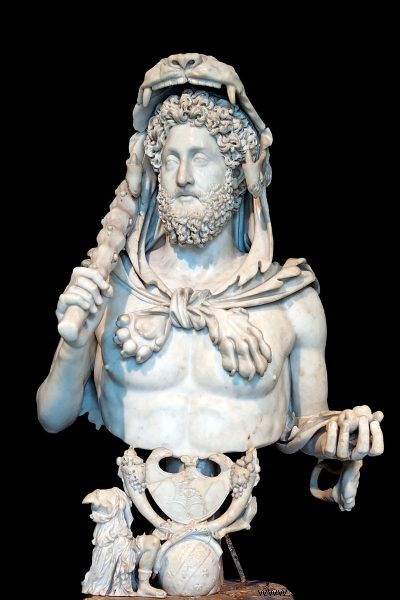
The Emperor Commodus, who used to dress in the garments of a hero, liked Hercules the most.
The cult of Hercules and the imperial ideology associated with it spread rapidly throughout the empire. The cult of this hero was very eagerly adopted in the provinces and was often associated with local deities.
In Gaul, for example, it was associated with the Celtic god Ogmios / Smertulus, who, like Hercules, was associated with regeneration and was a bridge between the world of the living and the dead. Both gods conquered death and became demigods. We now associate Ogmios with the deity from which all life comes. Hercules, however, according to the information that Diodorus Siculus gave us, was to be the ancestor of all Gauls . According to the myth, Hercules was to stay in Alesia during one of his trips, where he fathered a son named Galates with the daughter of the local king. This child was to give rise to the later Gauls.
The figure of Heracles / Hercules is extremely colorful and complex. This hero occupies a special place in ancient mythology, not only because of his deeds, but also, and perhaps above all, because of his connections and a deserved place in imperial ideology. He was one of the unifying elements of the Roman Empire, and his deeds were certainly well known.
Heracles also has a unique place in our culture . It was and is used many times in art, cinematography and widely understood pop culture.
Literature:
- Adkins L., Adkins R.A., Dictionary of Roman Religion , Oxford 1996
- Beard M., North J., Price S., Religions of Rome. Vol. 1 A history , Cambridge 1998
- Berens E. M., The Myths and Legends of Ancient Greese and Rome , Amsterdam 2009
- Hannestad N., Roman Art and Imperial Policy , Aarhus University Press 1986
- Wojciechowski P., Worshipers of Hercules in Rome , Toruń 2005
